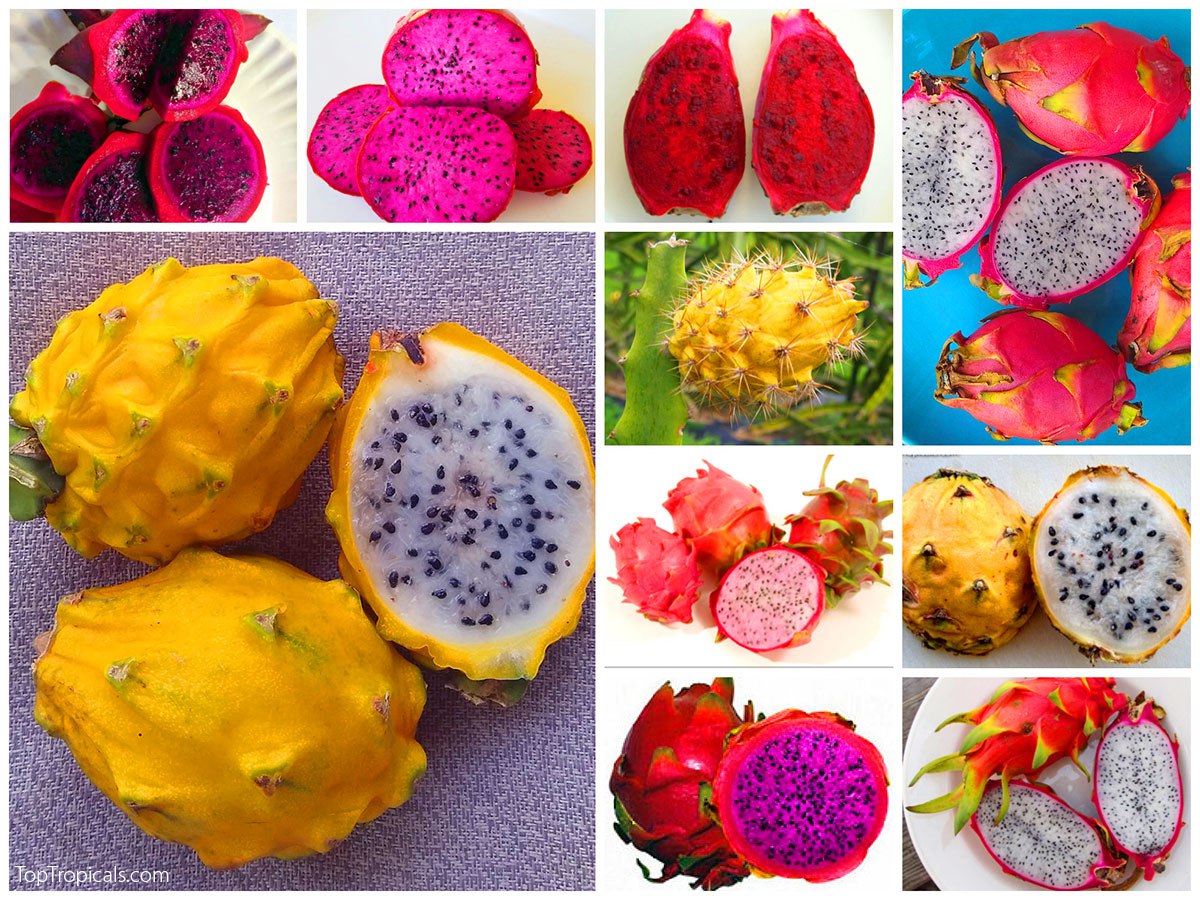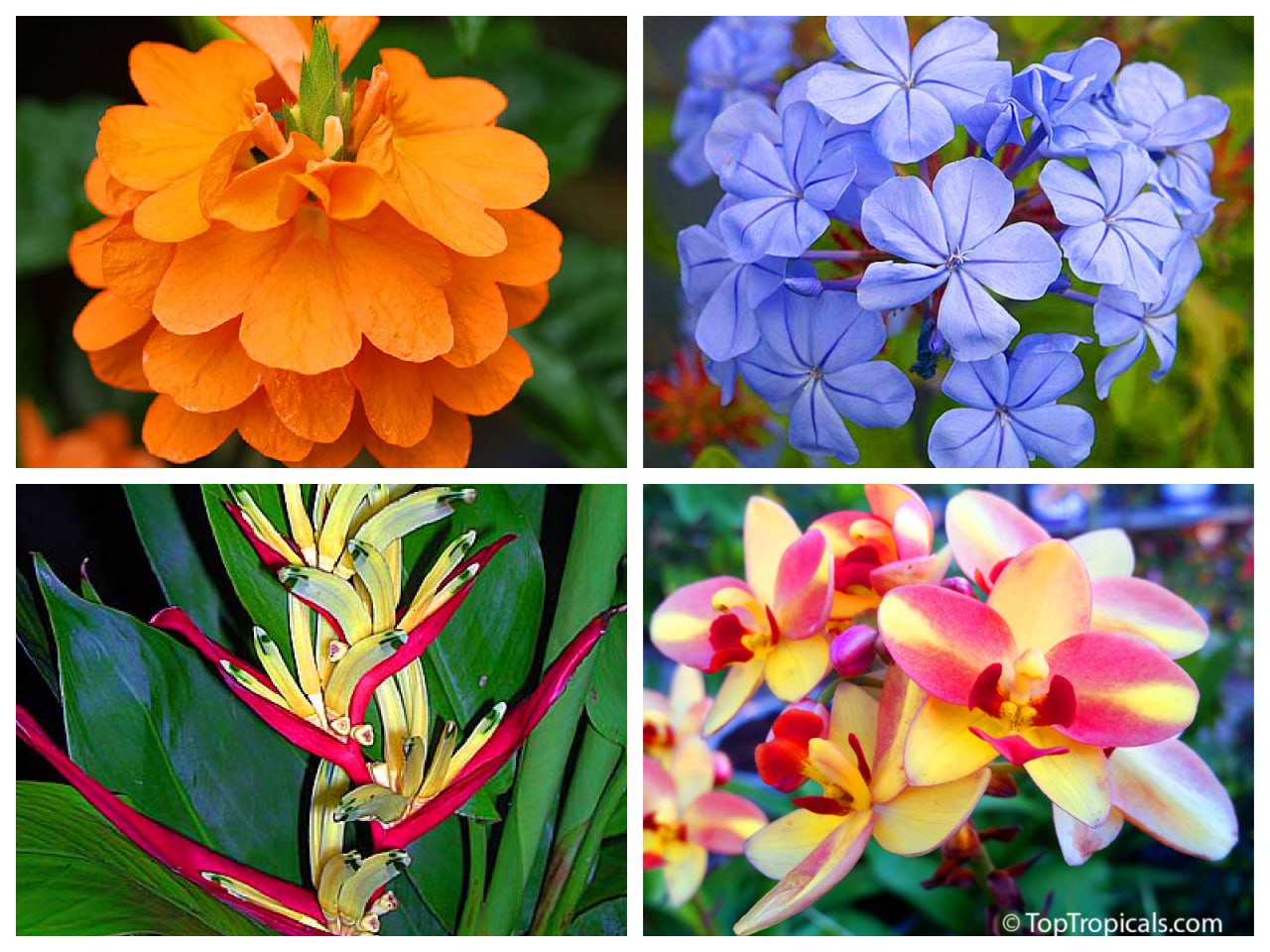Garden Blog - Top Tropicals
Pitaya vs Dragon fruit - what is the difference and how to grow it?
🌵 Pitaya vs Dragon fruit - what is the difference and how to grow it?
🍉 Dragon fruit varieties
Varieties: Cosmic Charlie, Edgar's Baby, Halleys Comet, Natural Mystic, Physical Graffiti, Purple Haze, Tricia, Voodoo Child, Zamorano
🟡⚪️ Yellow skin, white flesh (Hylocereus, or Selenicereus megalanthus) - Smaller fruit, but the sweetest of all. Crisp, juicy, and tropical with notes of pineapple or honey.
Varieties: Amarilla (Kirin), Colimbiana, Godlen Dragon, Palora, Thai Gold (Hawaiian)
Each type looks stunning and tastes slightly different, but all are easy to grow once you give them sun, support, and patience.
🛒 Explore and collect Dragon Fruit varieties
📚 Learn more:
#Food_Forest #How_to #Dragon_Fruit
🟢 Join 👉 TopTropicals
🍉 Pitaya and Dragon Fruit are the same plant!
🍉 How to grow Dragon Fruit
Both names refer to climbing cacti in the genus Hylocereus. The word pitaya is more common in Latin America, while dragon fruit is the name used in Asia and English-speaking countries. They come in different types: white-fleshed (Hylocereus undatus), red-fleshed (Hylocereus costaricensis), and yellow-skinned (Hylocereus, or Selenicereus megalanthus). All share the same growth habit and care needs. Pitaya or dragon fruit - whichever name you use, it's one of the easiest exotic fruits to grow at home.
- ▫️Get a desired variety or start from a cutting - let the cut end dry for a few days before planting to prevent rot.
- ▫️Plant in well-draining soil with lots of sun.
- ▫️Give it a strong support to climb on - it's a vining cactus.
- ▫️Water deeply but let the soil dry between waterings.
- ▫️Flowers open at night and need pollination - some types are self-fertile, others need cross-pollination.
- ▫️With care, you can enjoy fruit in 1-2 years. Remember to ferilize!
🍉 Dragon fruit varieties
🔴 ⚪️ Red skin, white flesh (Hylocereus undatus) - The most popular type, and the biggest fruit. Mildly sweet, refreshing, and often compared to a kiwi crossed with a pear.
🔴🔴 Red skin, red flesh (Hylocereus costaricensis) - Sweeter, juicier, and more intense in flavor. The deep red juice can stain, but it’s loaded with antioxidants.
🔴🟣 Red flesh, purple/magenta flesh (Hylocereus x costaricensis) - Hybrids, usually between red and white varieties.
Varieties: David Bowie, Delight, Hana, Lake Atitlan, Seoul Kitchen, Vietnamese Jaina, Hana
Varieties: American Beauty, Bloody Mary, Eureka Red, Costa Rican Sunset, Mac Edwin, Halleys Comet, Mac Edwin, Makisupa, Mega Red, Physical Graffiti, Sweet Red
Varieties: Cosmic Charlie, Edgar's Baby, Halleys Comet, Natural Mystic, Physical Graffiti, Purple Haze, Tricia, Voodoo Child, Zamorano
🟡⚪️ Yellow skin, white flesh (Hylocereus, or Selenicereus megalanthus) - Smaller fruit, but the sweetest of all. Crisp, juicy, and tropical with notes of pineapple or honey.
Varieties: Amarilla (Kirin), Colimbiana, Godlen Dragon, Palora, Thai Gold (Hawaiian)
Each type looks stunning and tastes slightly different, but all are easy to grow once you give them sun, support, and patience.
🛒 Explore and collect Dragon Fruit varieties
📚 Learn more:
- · How to grow Dragon Fruit from a cutting - Quick Guide
- · How to grow Dragon Fruit 📱
- · Planting your own Dragon Fruit plantation
- · Do-It-Yourself Support Structure for Dragon Fruit
- · Grow Your Own Exotic Dragon Fruit Garden
- · Top 10 fruit you'll ever need for your health benefits: Dragon fruit
- · What does Dragon Fruit Flower look like?
- · Why you need to grow your own dragon fruit
- · Do red, white and yellow Dragon fruit taste differently?
- · What to do with a lot of Dragon Fruit
#Food_Forest #How_to #Dragon_Fruit
🟢 Join 👉 TopTropicals
Avocado shrimp boats: Quick-n-Fun exotic recipes
🍴 Avocado shrimp boats: Quick-n-Fun exotic recipes
🛒 Grow your own Avocado tree
#Food_Forest #Recipes #Avocado
🟢 Join 👉 TopTropicals
🟢Halve an avocado, scoop out a little extra.- 🟢Fill with sauteed shrimp tossed in garlic-lime butter.
- 🟢Enjoy instant tropical feast!
🛒 Grow your own Avocado tree
Avocado shrimp boats: Quick-n-Fun exotic recipes
Ingredients
- 2 ripe avocados
- 1 cup shrimp, peeled and deveined
- 2 tbsp butter
- 2 cloves garlic, minced
- 1 tbsp lime juice
- Salt and pepper, to taste
- Fresh parsley, chopped (for garnish)
Instructions
- Halve the avocados and scoop out a little extra to make room.
- Sauté shrimp in butter with garlic and lime juice until pink and cooked through.
- Season with salt and pepper.
- Fill avocado halves with shrimp mixture.
- Garnish with parsley and serve immediately.
#Food_Forest #Recipes #Avocado
🟢 Join 👉 TopTropicals
Harmony
🍑 Harmony
"Happiness is when what you think, what you say, and what you do are in harmony." - Mahatma Gandhi
🐈📸 Bob the Cat is in harmony at TopTropicals PeopleCats.Garden
#PeopleCats #Quotes
🟢 Join 👉 TopTropicals
"Happiness is when what you think, what you say, and what you do are in harmony." - Mahatma Gandhi
🐈📸 Bob the Cat is in harmony at TopTropicals PeopleCats.Garden
#PeopleCats #Quotes
🟢 Join 👉 TopTropicals
Night jasmine that disappears with sunrise: Parijat
Nyctanthes arbor-tristis - Parijat, Night Jasmine, Sad Tree, Tree of Sorrow
💔 Night jasmine that disappears with sunrise: Parijat
Yes - if your climate cooperates. Parijat grows up to 10 feet tall, handles full sun or light shade, and thrives in well-drained soil with regular, moderate watering. It blooms best with monthly fertilizer and tolerates light cold (into the 30s F). In cooler areas, grow it in a container. Regular pruning helps it stay compact and flower more.
🛒 Plant Parijat - the tree smell like heartbreak and heaven
📚 Learn more:
#Perfume_Plants #Trees #Discover
🟢 Join 👉 TopTropicals
- 💔 Nyctanthes arbor-tristis, Parijat, Night Jasmine, Sad Tree or Tree of Sorrow... What secret is hidden in this flower?
- 💔 Parijat is a small tree or shrub from South Asia known for its intensely perfumed white flowers with bright orange centers that open at dusk and fall by dawn.
- 💔 What is Parijat famous for?
- 💔 Why do people plant Parijat?
- 💔 Is Parijat easy to grow?
Mostly for its scent and stories - but locals also use it in traditional remedies. The flowers are beloved in temple garlands and perfumery. Leaves, flowers, bark, and seeds are used in Ayurveda for treating fevers, sciatica, arthritis, and more. Extracts also show anti-inflammatory and liver-protective effects in modern studies.
It’s both fragrant and spiritual. Parijat is sacred in Hindu myth - some say Krishna brought it from heaven, others that it sprang from a grieving princess’s ashes. People plant it near temples or in small gardens not just for the scent, but for its cultural symbolism and graceful beauty.
Yes - if your climate cooperates. Parijat grows up to 10 feet tall, handles full sun or light shade, and thrives in well-drained soil with regular, moderate watering. It blooms best with monthly fertilizer and tolerates light cold (into the 30s F). In cooler areas, grow it in a container. Regular pruning helps it stay compact and flower more.
🛒 Plant Parijat - the tree smell like heartbreak and heaven
📚 Learn more:
- ▫️Sacred perfume tree for small spaces: Parijat blooms with heartbreak and heaven
- ▫️Six most desired perfume plants
- ▫️Five best fragrant plants for summer plantings
#Perfume_Plants #Trees #Discover
🟢 Join 👉 TopTropicals
Count your age by friends
🐱 Count your age by friends
"Count your age by friends, not years. Count your life by smiles, not tears." - John Lennon
🐈📸 Cats Bob and Cash are buddies at TopTropicals PeopleCats.Garden
#PeopleCats #Quotes
🟢 Join 👉 TopTropicals
"Count your age by friends, not years. Count your life by smiles, not tears." - John Lennon
🐈📸 Cats Bob and Cash are buddies at TopTropicals PeopleCats.Garden
#PeopleCats #Quotes
🟢 Join 👉 TopTropicals






